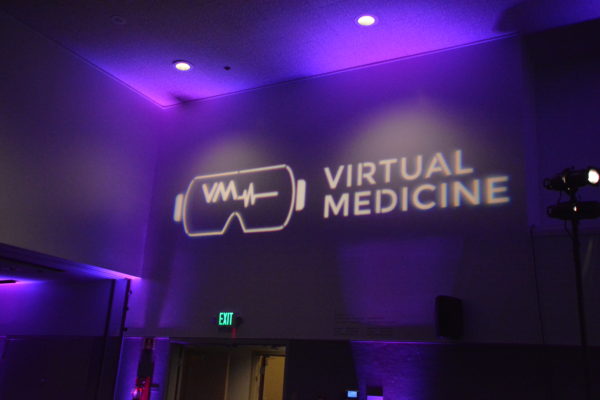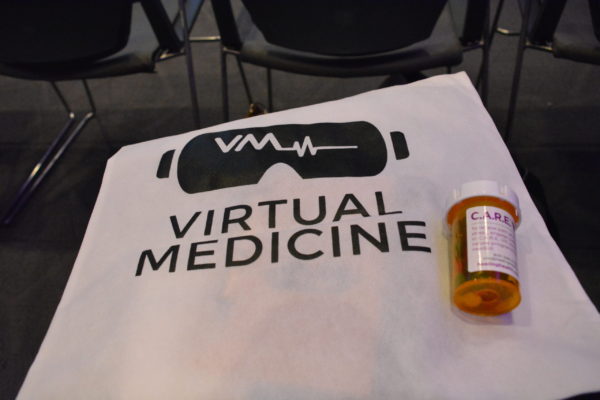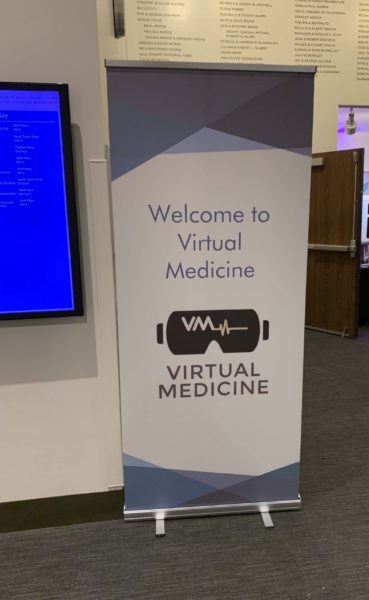by Dot Cannon

Virtual Medicine sign onsite during Virtual Medicine conference 2019, Los Angeles
“Typically, when we use racial disparities, we’re talking about difference,” said Dr. Courtney Cogburn.
The second hour of Cedars-Sinai’s inaugural “Virtual Medicine Webinar Series” session, on Tuesday, June 30th, had just begun. And Dr. Cogburn, who is both a psychologist and Associate Professor of Social Work at Columbia University, was beginning her presentation, “Developing Racial and Structural Competence Using VR”.
“Racial disparities persist (at every socioeconomic level),” she continued.
“…Racism is considered a fundamental cause of inequities in health. So, what are we doing in VR to help to address this?”
At Columbia University, Dr. Cogburn directs a research group which uses innovative means to identify racism, measure it and evaluate its effects on mental and physical health, according to the department’s website.
Dr. Cogburn said that her own answer to the question she raised, was to work with Stanford Virtual Human Interaction Lab Founder Jeremy Bailenson to create a transdisciplinary team. Their goal: to create new knowledge.
Consequently, Dr. Cogburn and her team designed a VR experience that could put the user in the role of someone of a different ethnicity than their own–and give users some new perspectives..
“What we created is based on empirical literature,” she said.
Experiencing life as a Black male
This VR experience, Dr. Cogburn continued, puts users in the shoes of a young Black character named Michael Sterling.
Michael’s experience begins in a kindergarten classroom. Michael is playing with blocks until a classmate goads him into throwing one–and he is punished.
“Based on empirical data, Black boys are unfairly disciplined for the same behavior (as their White counterparts),” Dr. Cogburn said.
The VR experience continues with a scene from Michael’s teenage years. Police accost him because his style of dress is the same as that of a wanted suspect.
“You hear your mother’s voice saying, ‘Just do what you have to do, to get home alive,'” Dr. Cogburn said.
Then, in the final scene, Michael is a young adult. He’s a Yale graduate, applying for a job.
But when the interviewer enters the reception area, he assumes another applicant–who is White–is the candidate from Yale. Michael’s application is ultimately rejected because he “doesn’t fit with the company culture”.
“We wanted to give you the sense of being dismissed and ignored,” Dr. Cogburn explained.
“White liberals often respond, ‘That’s not true, that doesn’t happen,’ and I can assure you that it does.
“The target group for this experience were white liberals…(and) they’re becoming more aware.”
Dr. Cogburn said she and her team are continuing their work in this area.
“We have a paper coming out soon…(and) we are also developing a new set of pieces here…and are working together.
“We’re interested in behavior, and how people analyze problems.”
A panel examines “what’s next”

“Virtual Medicine’ conference bag and candy on table during 2018 Virtual Medicine conference, Los Angeles.
Cedar’s-Sinai’s first session of their “Virtual Medicine Webinar Series” concluded with a panel discussion, which Dr. Brandon Birckhead moderated. Dr. Cogburn, Cedars-Sinai’s Dr. Brennan Spiegel, AppliedVR CEO Matthew Stoudt, Dr. Kate Donovan of Boston Children’s Hospital and Dr. Beth Darnell, of Stanford University were the panelists.
Their topics: new developments in medical virtual reality, and some of the obstacles barring widespread adoption.
Dr. Cogburn addressed the consideration of content bias in the area of pregnancy mortality among Black women.
“(It’s important to know the effects of stressful living environments on health),” she said. (“How does our policy impact mortality, and how did social environment contribute to those outcomes?”)
Dr. Donovan, who is Clinical Director of Innovation at Boston Children’s Hospital, said her team is currently working with an advisor to develop VR experiences for their young patients.
“We also have created an app called Health Voyager,” she said. “The kids actually use small little VR goggles to engage with this on their phone.”
But, she said, there was an important factor to keep in mind.
“With pediatrics, you have to take into consideration the parent,” she said. “We’re (transporting the child into other virtual worlds), so that leaves a very anxious parent by themselves.”
Next, the panel examined the reasons why medical virtual reality isn’t currently more widely used.
“At this point are we ready to deploy?” asked Dr. Cogburn. “I think we take a very academic approach to VR. We’ve covered the turf. It’s time to get it out into the field.”
“We need to examine (the) barriers to adoption at the organizational level, individual level, and the national level,” said Dr. Darnell. “We need to have policymakers at the table so we understand what it takes to get a VR headset into every household.”
Moving forward

Welcoming attendees to Cedars-Sinai’s “Virtual Medicine” conference, Los Angeles, 2019.
Misperception was also a problem, Dr. Donovan commented. “(VR) was first adopted as a gaming device, so a lot of times, (people interpret its use as), “you want to add more games”.
“How can we get this implemented on a societal level?” Dr. Birckhead asked.
“Just having clinical evidence isn’t enough,” Matthew said. “You’ve got to be able to demonstrate that patients are willing to put (the headset) on.”
And those headsets, he said, had been an obstacle.
“Is it easy to use?…Patients tend to skew older (and the headset can be intimidating).”
“The third part of the equation,” Matthew continued, “who pays?
“I think one of the biggest areas (where healthcare costs will come down) is when you take this into the home.”
Cedars-Sinai’s first “Virtual Medicine Webinar” was in its final minutes. The two hours had been packed with updates and information on the current status of medical virtual reality.
Dr. Spiegel concluded the session with a recent development.
“The FDA has just started a new XR program, literally the week before lockdown,” he said.
“We just have to keep chipping away at it. It seems a little Sisyphean at times (but we will make it work).”
Cedars-Sinai will be planning additional virtual sessions in the future. Here’s the link for updates on their “Virtual Medicine Webinar Series”. In addition, you’ll find videos from their inaugural “Best Practices in Virtual Medicine” conference in 2018, and their 2019 conference.
And here’s the link for more information on Dr. Brennan Spiegel’s forthcoming book, “VRx”, which will release on October 6th, 2020.
This is Part Two of a two-part series. Missed Part One? Here’s the link.
